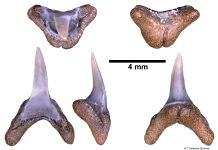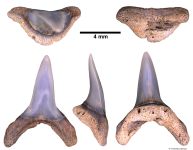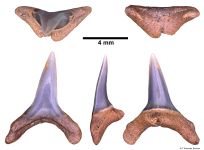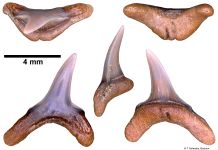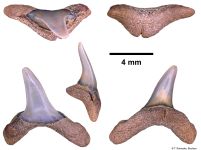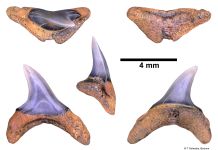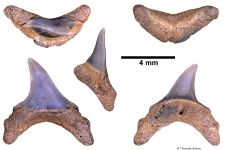Alopias crochardi
Ward, 1978
Classification: Elasmobranchii Lamniformes Alopiidae
Reference of the original description
Additions to the fish fauna of the English Palaeogene. 1. Two new species of Alopias (Thresher Shark) from the English Eocene. Tertiary Research, 2(1), 23–28
Additions to the fish fauna of the English Palaeogene. 1. Two new species of Alopias (Thresher Shark) from the English Eocene. Tertiary Research, 2(1), 23–28
Image of the original description
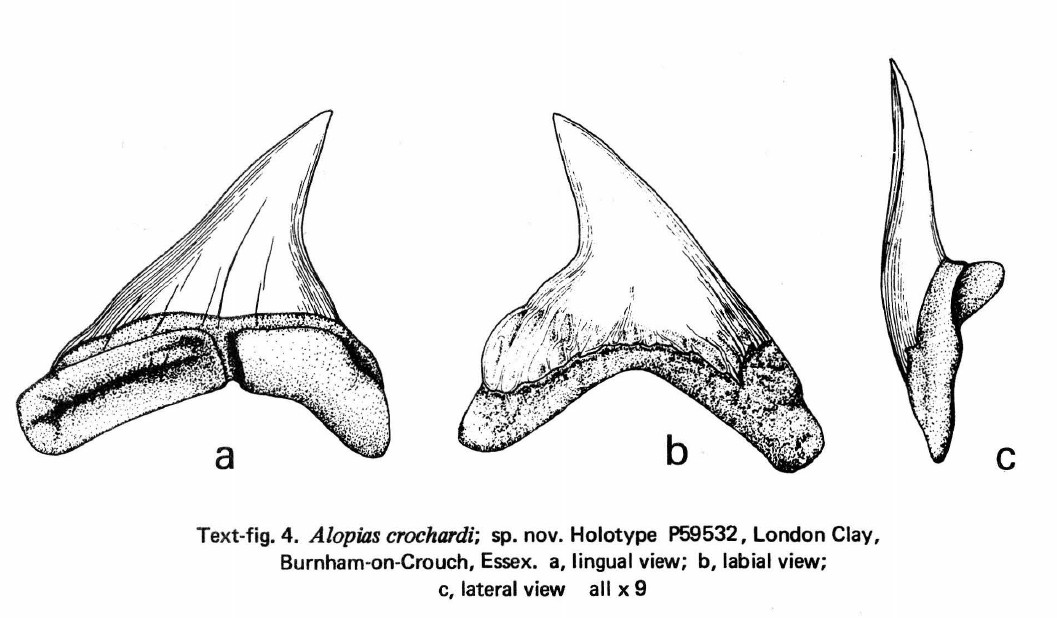
Alopias crochardi Ward, 1978; Holotype P59532, London Clay Formation, Division D, Sheppey Member, Ypresian, early Eocene; Cliff Reach, Burnham-on-Crouch, UK © D. Ward

Alopias crochardi Ward, 1978; Holotype P59532, London Clay Formation, Division D, Sheppey Member, Ypresian, early Eocene; Cliff Reach, Burnham-on-Crouch, UK © D. Ward
Description:
Citation: Alopias crochardi Ward, 1978: In: Database of fossil elasmobranch teeth www.shark-references.com, World Wide Web electronic publication, Version 12/2025
Please send your images of "Alopias crochardi" to info@shark-references.com
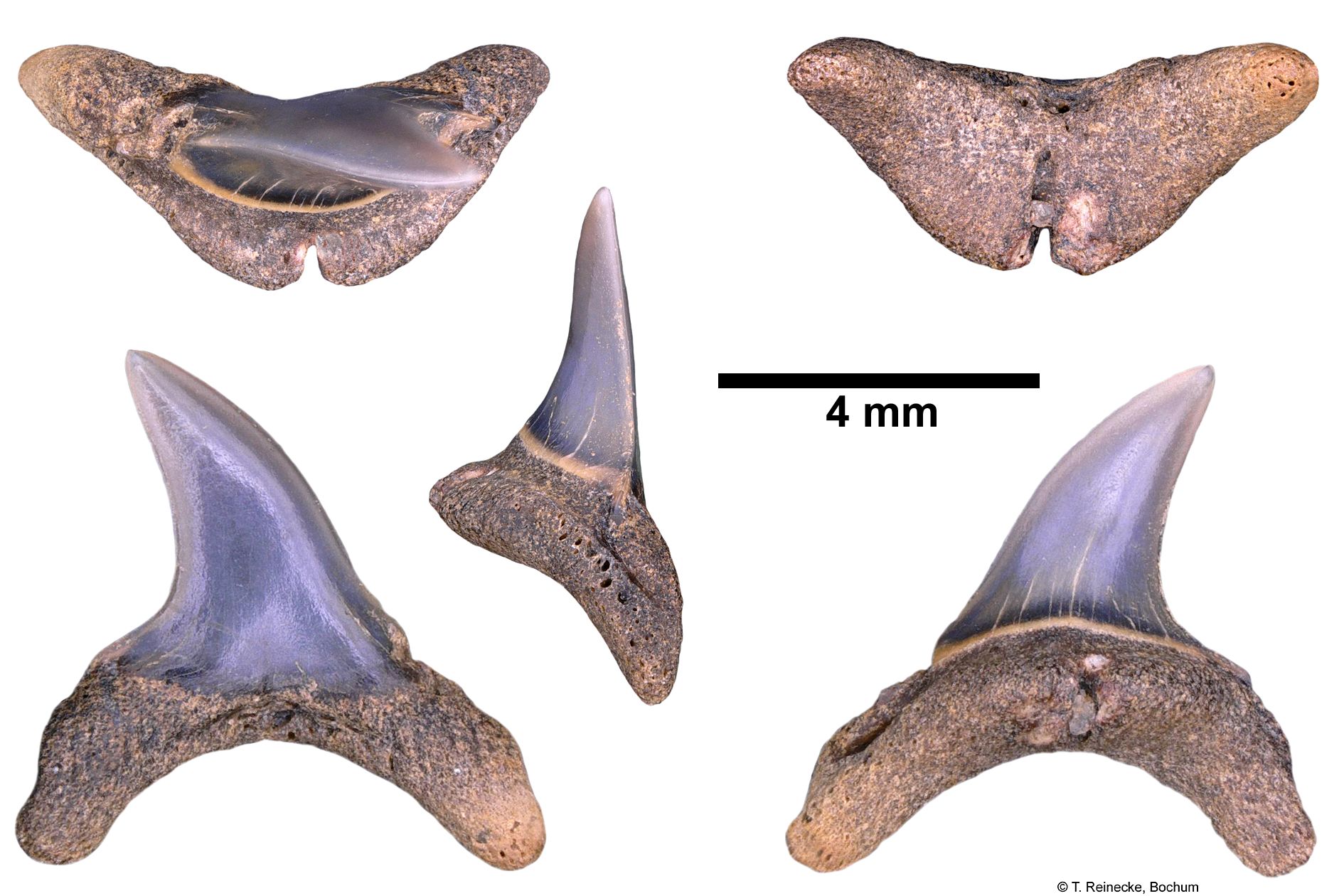
Alopias crochardi Ward, 1978; London Clay Formation, Division D, Sheppey Member, Ypresian, early Eocene; Cliff Reach, Burnham-on-Crouch, UK © T. Reinecke, Bochum

Alopias crochardi Ward, 1978; London Clay Formation, Division D, Sheppey Member, Ypresian, early Eocene; Cliff Reach, Burnham-on-Crouch, UK © T. Reinecke, Bochum
Description
Original diagnosis after Ward (1978) p. 25 [2491]: Alopias known only by isolated fossil tooth. Crown low, triangular, commissurally inclined, inflated and laterally expanded at the base. Root widely divergent and almost entirely covered by the crown. Median groove present, probably well developed.
Original diagnosis after Ward (1978) p. 25 [2491]: Alopias known only by isolated fossil tooth. Crown low, triangular, commissurally inclined, inflated and laterally expanded at the base. Root widely divergent and almost entirely covered by the crown. Median groove present, probably well developed.
References

Fossile hajtaender fra Trelde Naes. Self-published

Climate cooling and clade competition likely drove the decline of lamniform sharks. Proceedings of the National Academy of Sciences of the United States of America, 116(41), 20584–20590
DOI: 10.1073/pnas.1902693116
A study of the sharks and rays from the Lillebælt Clay (Early–Middle Eocene) of Denmark, and their palaeoecology. Bulletin of the Geological Society of Denmark, 62, 39–88
DOI: 10.37570/bgsd-2014-62-04

London Clay Fossils of Kent and Essex. Rochester, Kent, Medway Fossil and Mineral Society, 228 p, ISBN: 978–0–9538243–1–1

Fossil sharks, rays and chimaeroids of the English Tertiary period. Gosport Museum, 1–47, 10 fig., 3 tabl., 16 pl.

The distribution of sharks, rays and chimaeroids in the English Palaeogene. Tertiary Research, 3(1), 13–19

Additions to the fish fauna of the English Palaeogene. 1. Two new species of Alopias (Thresher Shark) from the English Eocene. Tertiary Research, 2(1), 23–28

Fossile hajtaender fra Trelde Naes. Self-published

Climate cooling and clade competition likely drove the decline of lamniform sharks. Proceedings of the National Academy of Sciences of the United States of America, 116(41), 20584–20590
DOI: 10.1073/pnas.1902693116
A study of the sharks and rays from the Lillebælt Clay (Early–Middle Eocene) of Denmark, and their palaeoecology. Bulletin of the Geological Society of Denmark, 62, 39–88
DOI: 10.37570/bgsd-2014-62-04

London Clay Fossils of Kent and Essex. Rochester, Kent, Medway Fossil and Mineral Society, 228 p, ISBN: 978–0–9538243–1–1

Fossil sharks, rays and chimaeroids of the English Tertiary period. Gosport Museum, 1–47, 10 fig., 3 tabl., 16 pl.

The distribution of sharks, rays and chimaeroids in the English Palaeogene. Tertiary Research, 3(1), 13–19

Additions to the fish fauna of the English Palaeogene. 1. Two new species of Alopias (Thresher Shark) from the English Eocene. Tertiary Research, 2(1), 23–28








